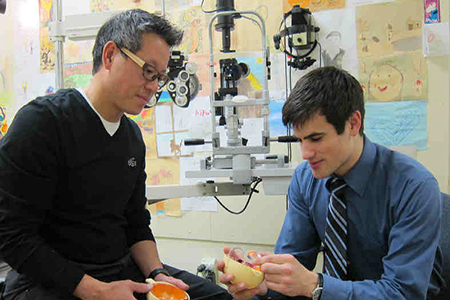RIGHT NOW is a great time to be an artist. Art is expanding like never before — in new and exciting directions. Some of the fastest growing art careers are in “non-traditional” fields like fashion design gaming and multimedia design.
Today the fine arts are as varied as they are creative — from “traditional” art (painting sculpting photography etc.) to “applied arts” (industrial and environmental design) — and today’s fine arts programs reflect that diversity.
Across the country fine arts students are as likely to be found seated in front of a computer as they are in front of an easel. With the development of new media (aided by advanced technology) students are venturing into a wide array of dynamic programs such as graphic design animation motion graphics editorial design and video production. These programs which often draw upon multiple disciplines allow students to flex their creativity and strengthen their range as artists — a diversity that’s valuable to future employers.
As art continues to take center stage affecting everything from our landscape to our consumer choices art and design programs continue to grow and strengthen. Environmental and product design programs have grown in response to concerns over sustainability material usage and design innovation in both consumer products and the environment.
If you think a career in the arts is right for you your next step is to decide which type of school you’d like to attend in order to obtain your Bachelor of Fine Arts (BFA) degree. You can either study at a specialized art school or in the art department of a traditional college or university. Keep in mind that a BFA degree must have a certain ratio of liberal arts to studio courses no matter the school and that specialty art schools typically offer a strong liberal arts curriculum.
Whichever path you choose remember that fine arts and design programs can be highly competitive. Here’s what you need to know about applying.
Know Your Audience
Do your research. Check out the websites of the schools you’re interested in applying to. Find out what programs and courses are offered who the faculty members are and what connections the school has to museums galleries and art/design firms. Many school websites feature student image collections which are useful in observing the kind and quality of work that is created. Look for schools whose programs and art speak to your interests. Investigate how the graduates of a school have fared in obtaining art or design-related jobs.
Ask yourself some questions: Do I want to be in a big or small city? Would I rather be in a large or close-knit academic setting? What am I most interested in studying? Do I want a highly-focused or interdisciplinary program?
If possible try to visit the schools you are considering. In person you can more easily get a sense of the school’s facilities equipment environment and student body. In a highly specialized art or design program these elements can be crucial. If you can’t visit a school see if you can speak with a current student who is studying in your field.
SALARIES
You may be wondering how much artists designers and other creative professionals earn. Here are the mean salaries for certain careers open to graduates with fine arts and design degrees. Keep in mind that salaries vary by geographic location. Additionally as these are average salaries among all individuals in the specified field the starting salaries will typically be less.
Average Starting Salaries for Engineers by Degree
| Art Directors: | $83,230 |
| Commercial and Industrial Designers: | $60,540 |
| Fine Artists Including Painters Sculptors and Illustrators: | $48,110 |
| Graphic Designers: | $45,340 |
| Fashion Designers: | $71,170 |
| Interior Designers: | $50,190 |
| Multi-media Artists and Animators: | $61,010 |
| Source: U.S. Department of Labor” Bureau of Labor Statistics — May 2007 |
Put Pen to Paper (or Mouse to Monitor!)
Colleges are looking for dedication and determination in their art and design applicants. Your application should reflect your commitment to your work and to the field of art. While transcripts recommendations and test scores are important your art portfolio will be a crucial component of your college application.
“The portfolio is the gateway into consideration at Kendall,” says Kristopher Jones, admissions officer at Kendall College of Art and Design of Ferris State University. “I am looking for a student who proves they have technical ability and passion.”
You should begin to think about your portfolio long before you fill out your college applications. “If you don’t keep a sketchbook start,” says Judith Aaron, vice president for enrollment at Pratt Institute. “And draw draw draw.”
Many art schools like the Maryland Institute College of Art (MICA) offer summer portfolio camps where high-school students can build their portfolios work with fellow artists and receive critique from college faculty.
“The pre-college summer program is a wonderful way for students to really develop their artistic skills and build a portfolio for admission and scholarship consideration,” says Theresa Bedoya, vice president for admission and financial aid at MICA. In addition to observational drawings (which many schools require) include pieces in your portfolio that best reflect your talents areas of interest and diversity as an artist. However it’s not necessary to show one of everything in your portfolio. Donna Moran of the Pratt Institute says to include “no more than 20 pieces” and adds that “10 good ones are better.”
Bring your portfolio to a National Portfolio Day near you. National Portfolio Day events take place throughout the country and provide art students with an excellent opportunity to meet with college representatives from a number of prominent schools. These representatives will be available to discuss their programs review your work and offer feedback.
While a solid portfolio is vital do not overlook the other components of your application. “Many prospective applicants are surprised to learn that we often deny more applications on the basis of a weak academic record than a below-average portfolio,” Ama Schulman, admissions counselor at MICA says.
Strong recommendations a passionate personal statement and a good interview can help identify you as an individual setting you apart from other talented hopefuls.
Art is Everywhere
You can see it in the last video you downloaded or in your new pair of sneakers. From product design to landscape design from animation to film production art is venturing into new fields creating new expressions concepts and possibilities.
As the boundaries between artistic fields become increasingly fluid the opportunities for artistic study continue to grow. MICA’s curatorial studies program was developed out of a response to the interdisciplinary nature of today’s art and design fields. Students in the program work through a range of disciplines — not only curating the show but also designing the exhibition placing the artwork and writing about the work shown. Bedoya says these “cross-disciplinary collaborations open up new avenues for artists and art careers.”
“Because of the greater use of technology artists are now working with multiple forms of media,” says Stan Trecker, dean of the Art Institute of Boston at Lesley University.
Joan Livingstone, professor and interim dean of undergraduate studies at the School of the Art Institute of Chicago notes that artists are exploring “a wide range of fabrication technologies… including the traditions of painting and sculpture … as well as digital facilities with 3-D modeling rapid prototyping image processing … and media editing.”
Many art programs emphasize the importance of practical industry related experience regardless of the field of study. Internship programs are strongly encouraged and often required. Sandy Britton, director of enrollment management at Kendall College of Art and Design of Ferris State University notes the importance of combining excellence in design with “strong business and practical real-world savvy” in order to create “working artists.”
As you pursue your artistic education remember to take full advantage of your school’s career connections in the form of internships networking events and faculty affiliations. Ask your teachers and school counselors for help in identifying the galleries design houses and companies most closely aligned with your area of focus and remember to always keep your portfolio filled with your best work.
Elizabeth Kotin is a freelance writer living in San Francisco.



